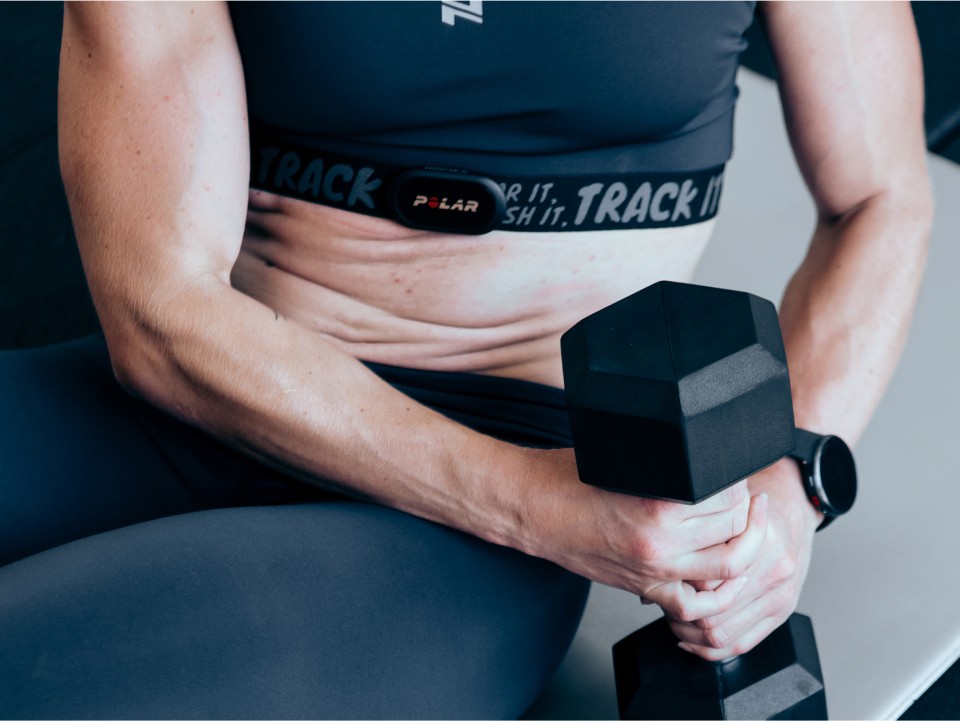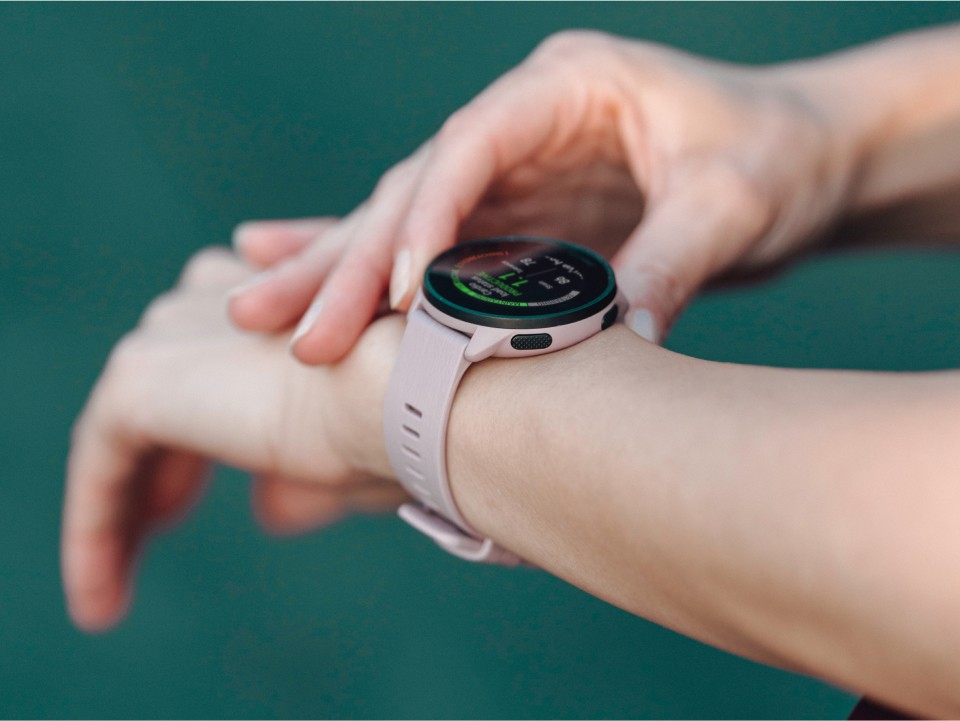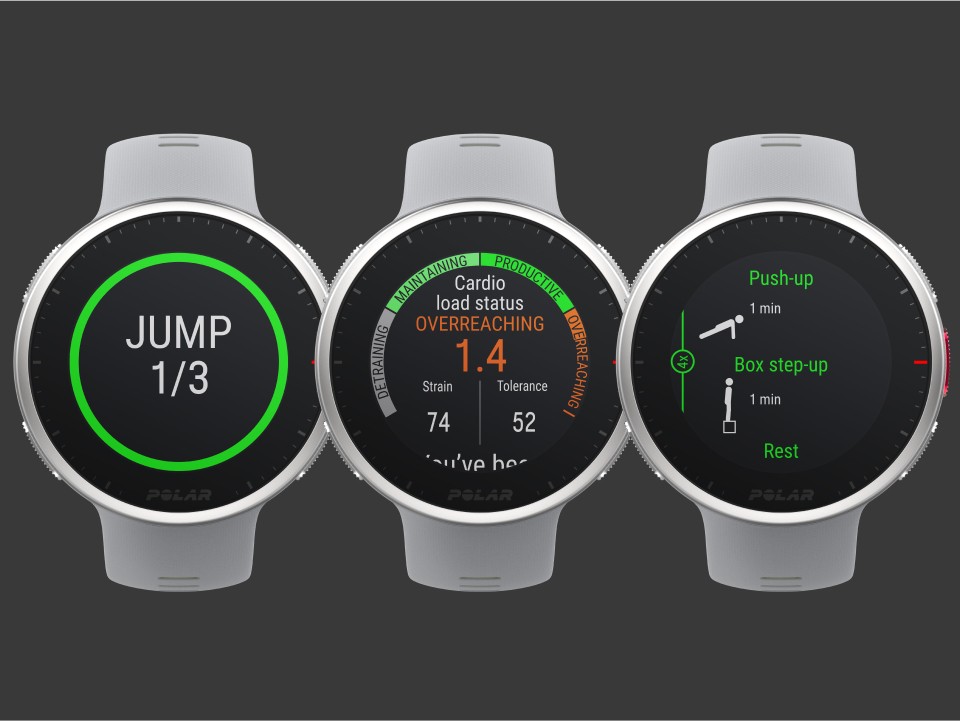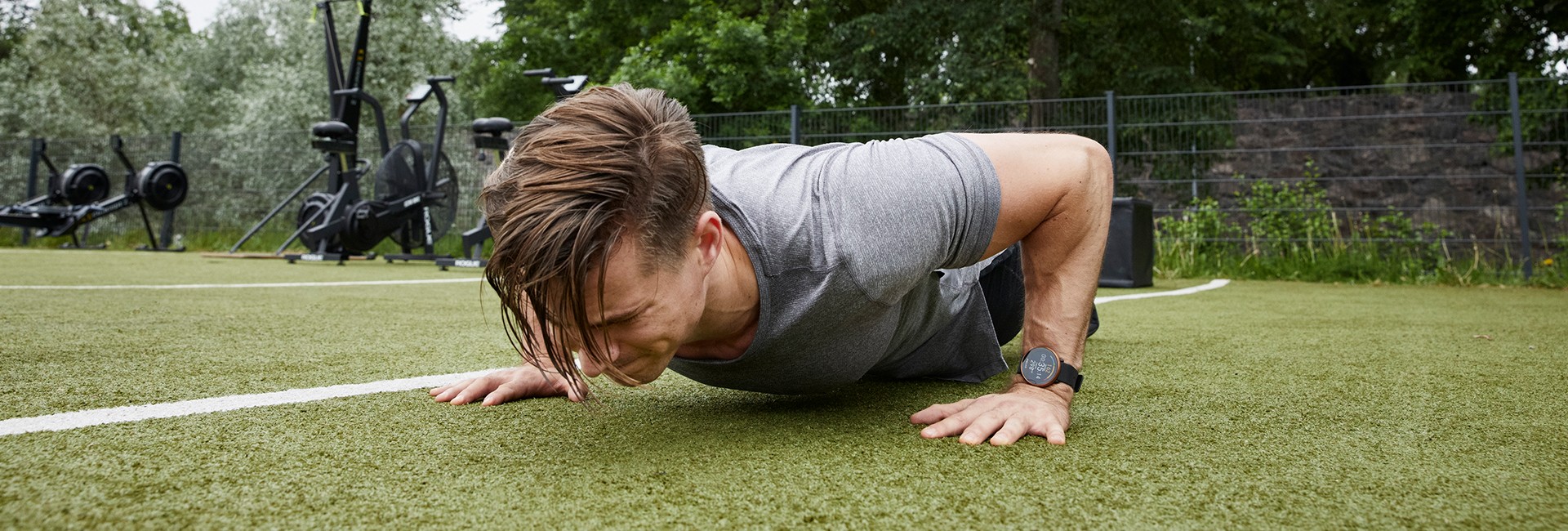How do you know if you’ve had a good workout at the gym? Your endorphins are pumping, your muscles are aching, and you’ve sweated buckets. But perhaps you’d like to know how this session compares to your last one. Or maybe it would help to understand how well you recovered last night, so you know what you have the capacity for today. That’s where using a heart rate monitor at the gym can help.
If you’re unsure if you need a chest strap or a sports watch, want to know how to connect your heart rate monitor to your gym equipment, or understand how your watch can guide you through your workout, here’s the guide you need to get the most out of your Polar device when training indoors.
Which type of heart rate monitor should you use in the gym?
When it comes to heart rate monitors, you have two options: chest or wrist. It’s a simple choice as there is a surprising amount of difference between these two options.
Using a chest strap in the gym

The chest strap is the original (and, some would say, still the best) way of monitoring your heart rate in the gym. As pioneers of wearable technology, Polar released the world’s first wireless heart rate monitor in 1982, and in 2017, a study published in the Journal of Medicine and Science in Sport and Exercise found the Polar chest strap to be the most accurate (with 99.6% accuracy).
A chest strap measures your heart rate through electrical activity (an electrocardiograph or ECG). This method is why you must wet your chest strap or apply a gel before using it so it can monitor the electric signals. As your strap sits on your chest, it measures your heart rate directly.
Polar H10 chest strap has ANT+, GymLink, and dual-band Bluetooth® Low Energy, which means you can use it to connect to gym equipment and multiple devices. It also has up to 30 hours of internal memory, so you can use it for long training sessions without needing an additional sports watch or smartphone nearby. You can also use it for regular Orthostatic Tests to avoid overtraining when you pair it with Polar watches that support this function.
So, the chest strap is the way to go if you are doing a type of gym training requiring high precision in monitoring your heart rate.
Using a sports watch in the gym

The sports watch is the most popular way of measuring your heart rate at the gym. It’s not uncommon to see someone checking their heart rate zone on their watch screen while they are mid-run on a treadmill or powering their way through a spin class.
A sports watch uses optical heart rate tracking (also known as photoplethysmogram or PPG). This PPG signal can be measured almost anywhere on the body and is then interpreted and used to calculate your heart rate. So, this less direct form of measurement, coupled with the bad habit of not wearing your sports watch snuggly, is the reason why optical heart rate tracking is more prone to errors than chest-strap-based heart rate.
Unless you have a reason for needing extreme precision with your monitoring (such as trying to achieve a new PB or preparing for a race), a sports watch will still provide you with exceptional tracking. It also has the added benefit of making your data instantly viewable so that you can adjust your training in real-time. Plus, you can also see how many calories you’ve burnt so far and control your music, all from your wrist.
So, if you are doing gym training where easily tracking and accessing your data is beneficial, the sports watch is the way to go.
Gym training guide
If you get stuck in the same routine every time you visit the gym, you’ll quickly become pretty bored with your repetitive workouts. When it comes to exercise, variety is the spice of life – but how do you mix things up?
You can create a workout program with a diverse range of training to suit your exercise needs. Create a weekly plan that covers different areas you want to focus on. If you’ve ever heard someone talk about it being their ‘leg day’ at the gym, then this is what they were talking about. You can also take this plan and create a variation based on it for the next couple of weeks, so you have a workout program that covers an entire month.

Another way to tailor your training guide is by using the data from your heart rate monitor in the gym. Polar FitSpark™ looks at how you’ve recovered the previous night, your fitness level, and what training you have recently completed to suggest a ready-made workout for you each day.
With FitSpark, the variation is already built-in to your workout plan. It focuses its recommendations on three categories – strength, cardio, and mobility – and offers up to four workouts so you can always choose what you’re in the mood for each day. It also offers step-by-step guidance throughout each session, so you can focus on what you’re doing in the moment rather than thinking about what is next.
Another significant benefit of FitSpark is that it helps you avoid fitness burnout. By tracking your rest and recovery, your Polar sports watch can make an informed recommendation for your daily workouts, ensuring you never push yourself beyond what your body is ready for.
Connecting your heart rate monitor in the gym
One of the best things about having a heart rate monitor in the gym is its connectivity. These days, most gyms have a range of equipment – from treadmills to rowing machines – that can connect with your device, so you can combine tracking your heart rate and workout with your equipment. Chat to your gym about which equipment is compatible with your heart rate monitor.
With Polar devices, you can also connect Polar Flow with a range of sports, training, and fitness apps. So you can focus on your gym workout while your apps communicate about it to each other. Check out the range of compatible apps from Nike Training Club and Strava Live segments to MyFitnessPal.
Using a heart rate monitor at the gym
You can use your heart rate monitor with every workout in the gym. Simply select the relevant Polar sport profile on your watch so you can track each type of exercise you do at the gym.
Several sport profiles for indoor training are set to automatically ‘broadcast’ your heart rate via Bluetooth so that they will easily connect with other devices such as gym equipment. Check out the complete list of Polar sport profiles to see which ones are enabled for broadcast.
Running in the gym
When using a treadmill for running in the gym, select the treadmill running sport profile. This one differs from the running/jogging/etc. profiles, which use GPS as part of tracking your workout.
In places where GPS is not always available, Polar watches can measure speed and distance from your wrist movements with a built-in accelerometer. To ensure maximum accuracy check that you’ve set your handedness and height correctly in your physical settings. Alternatively, instead of running with pace, you can choose to focus on your heart rate zones as they are always a phenomenal indication of your effort.
Pro tip: To enhance the accuracy of speed and distance measured from the wrist, the watch uses GPS offset calibration. Follow these simple instructions to calibrate GPS and ensure maximum accuracy.
Cycling in the gym
Like running, cycling in the gym cannot use GPS to track your workout as you aren’t moving. So, if you are using an exercise bike or doing a spin class in the gym, select the specific indoor cycling or spinning sport profiles (rather than cycling/electric biking/etc.).
You can always connect your sports watch to your bike if it has the capability, as it will probably track your pace. Alternatively, use your heart rate zones to track your effort instead.
Strength training at the gym
Strength training is a popular reason for visiting the gym because all those heavy weights and machines are ready for you to use. Depending on the type of training you are doing, select one of the following Polar sport profiles:
- Kettlebell
- Strength training
- Circuit training
Solo and group exercise at the gym
Whether you are doing a HIIT session on your own or trying a yoga class at the gym, there is a Polar sport profile for it. For workouts like indoor rowing and pool swimming, make sure you select these profiles and not similar ones based on GPS location (i.e., outdoor rowing and open-water swimming).
- Circuit training
- Cross-trainer
- High-intensity interval training
- Fitness dancing
- Aerobics
- Aqua fitness
- Group exercise
- Step workout
- Kickboxing
- Indoor rowing
- Pool swimming
- Body&Mind
- Core
- Mobility (dynamic)
- Mobility (static)
- Pilates
- Stretching
- Yoga
If you liked this post, don’t forget to share so that others can find it, too.
Or give it a thumbs up!
I like this article
Please note that the information provided in the Polar Blog articles cannot replace individual advice from health professionals. Please consult your physician before starting a new fitness program.

